AMD Carrizo Part 2: A Generational Deep Dive into the Athlon X4 845 at $70
by Ian Cutress on July 14, 2016 9:00 AM ESTAnalyzing Generational Updates
Going through the benchmark data for our Carrizo part compared to Kaveri, Richland and Trinity gives two very different sides of the same story. Simply put, it would come across that Carrizo is overall better at CPU tasks when you compare clock for clock, but performs worse when a discrete graphics card is in play for gaming. There are some slight exceptions for both sides of this story, especially when larger memory accesses comes in, but this comes down to the design choices when Carrizo for desktop was made. The fact that we have a laptop CPU in desktop clothing is going to be a main detractor when it comes to gaming, but the CPU compute side of the equation is very promising indeed.
In our generational testing, we compared the following four processors at 3 GHz and running the highest supported JEDEC memory speeds for each:
| AMD CPUs | ||||||||||||
| µArch / Core |
Cores | Base Turbo |
TDP | DDR3 | L1 (I) Cache |
L1 (D) Cache |
L2 Cache |
|||||
| Athlon X4 845 |
Excavator Carrizo |
4 | 3500 3800 |
65 W | 2133 | 192KB 3-way |
128KB 8-way |
2 MB 16-way |
||||
| Athlon X4 860K |
Steamroller Kaveri |
4 | 3700 4000 |
95 W | 1866 | 192KB 3-way |
64KB 4-way |
4 MB 16-way |
||||
| Athlon X4 760K |
Piledriver.v2 Richland |
4 | 3800 4100 |
100 W | 1866 | 128KB 2-way |
64KB 4-way |
4 MB 16-way |
||||
| Athlon X4 750K |
Piledriver Trinity |
4 | 3400 4000 |
100 W | 1866 | 128KB 2-way |
64KB 4-way |
4 MB 16-way |
||||
It is worth noting that for the most part the X4 750K and X4 760K are essentially equal, using a slightly modified Piledriver v2 microarchitecture for the X4 760K that in most cases performs similarly to the other processor at the same frequency. This will come through in almost all of our benchmark comparisons. However, the main battle will be between the top two.
Comparing the Upgrade: 2012 to 2016
Our results are going to be compared in two different ways. Firstly, we are going to look at the absolute improvement of each processor compared to the lowest one in the test: Trinity. This gives a direct analysis of the performance increase per clock total increase for every generation from 2012 to 2016. What follows is a series of graphs for each of our benchmark sections showing the results of each benchmark as a percentage improvement over Trinity. We'll analyze each one in turn.
From our Real World benchmarks, Carrizo gets a good showing in three of the benchmarks, showing a sizeable jump over Kaveri, however WinRAR and WebXPRT are a little lower.
For the office tests, Carrizo takes the biggest gain for CineBench and Handbrake, but sits behind in Photoscan and Hybrid. HandBrake shows a sizable gain in both tests compared to Trinity.
The Linux-Bench tests shows Carrizo behind Kaveri in each instance, and behind Richland for all three Redis tests. As we explained in that section, Redis is very memory dependent and as a result, despite having the larger L1 cache, only having 2 MB of L2 cache is a blow to the Carrizo part.
So here is where it is interesting. If you were only looking at synthetic and legacy tests in isolation, like many other review websites do, then you could be forgiven that it shows Carrizo taking a distinct lead in every benchmark (except 7-zip). In many cases there is a 10-20% gain over Kaveri.
For gaming, as explained in the testing, despite the improvement over Trinity that Carrizo offers, the deficit to Kaveri is consistent across the board.
Comparing IPC
Next, we have the generational updates moving from Trinity to Richland to Kaveri to Carrizo. This is where we typically expect to see single-digit percentage increases moving through the generations, with double digits for large gains or introduction of new IP blocks into the silicon (e.g. encryption or video conversion). Again, we go through each of our five benchmark sections for this.
3DPM v2 takes the biggest gain, a massive 32% over Kaveri, due to better memory management and a larger L1 cache. WinRAR, being memory dependent, loses due to the smaller L2.
The office tests are a mixed bag - we see a regression in Photoscan due to large memory accesses, but it is clear that Kaveri was a bigger jump for a number of things than Carrizo.
Our Linux tests get a poor showing across the board from Carrizo, which we saw in the results. In each case, the IPC for Carrizo is lower than that of Kaveri.
Back with the previous legacy results graph, we saw that Carrizo had a better performance than Kaveri across the board, except 7-zip. Translating this to IPC improvements and we see that in half the cases, moving to Kaveri was better than moving to Carrizo, with CineBench single threaded tests being the exception showing the capability of the core logic in Carrizo.
However, the big result will be for gaming. Clock for Clock, Carrizo gives an average 5.8% decrease in performance to Kaveri.
Conclusions
Wrapping all the numbers together, we get the following average IPC improvements for a Carrizo with 2MB of L2 cache over Kaveri with 4MB of L2 cache for each section:
| AMD Average IPC Increases | |||||||
| Benchmark Suite | Richland over Trinity | Kaveri over Richland | Carrizo over Kaveri | ||||
| Real World | 0.8% | 8.0% | 8.8% | ||||
| Office | -0.1% | 11.1% | 4.1% | ||||
| Legacy | 0.1% | 11.8% | 8.5% | ||||
| Overall Windows |
0.3% | 10.3% | 7.3% | ||||
| Linux | 10.4% | 10.5% | -12.1% | ||||
| Gaming | -0.4% | 12.5% | -5.8% | ||||
The headline figure, for CPU compute benchmarks (real world, office and legacy), is that Carrizo offers a +7.3% improvement over AMD's previous microarchitecture, Kaveri. It comes with the caveat that Linux and Gaming performance, which in our tests tend to rely more on memory accesses, perform 6-12% worse.


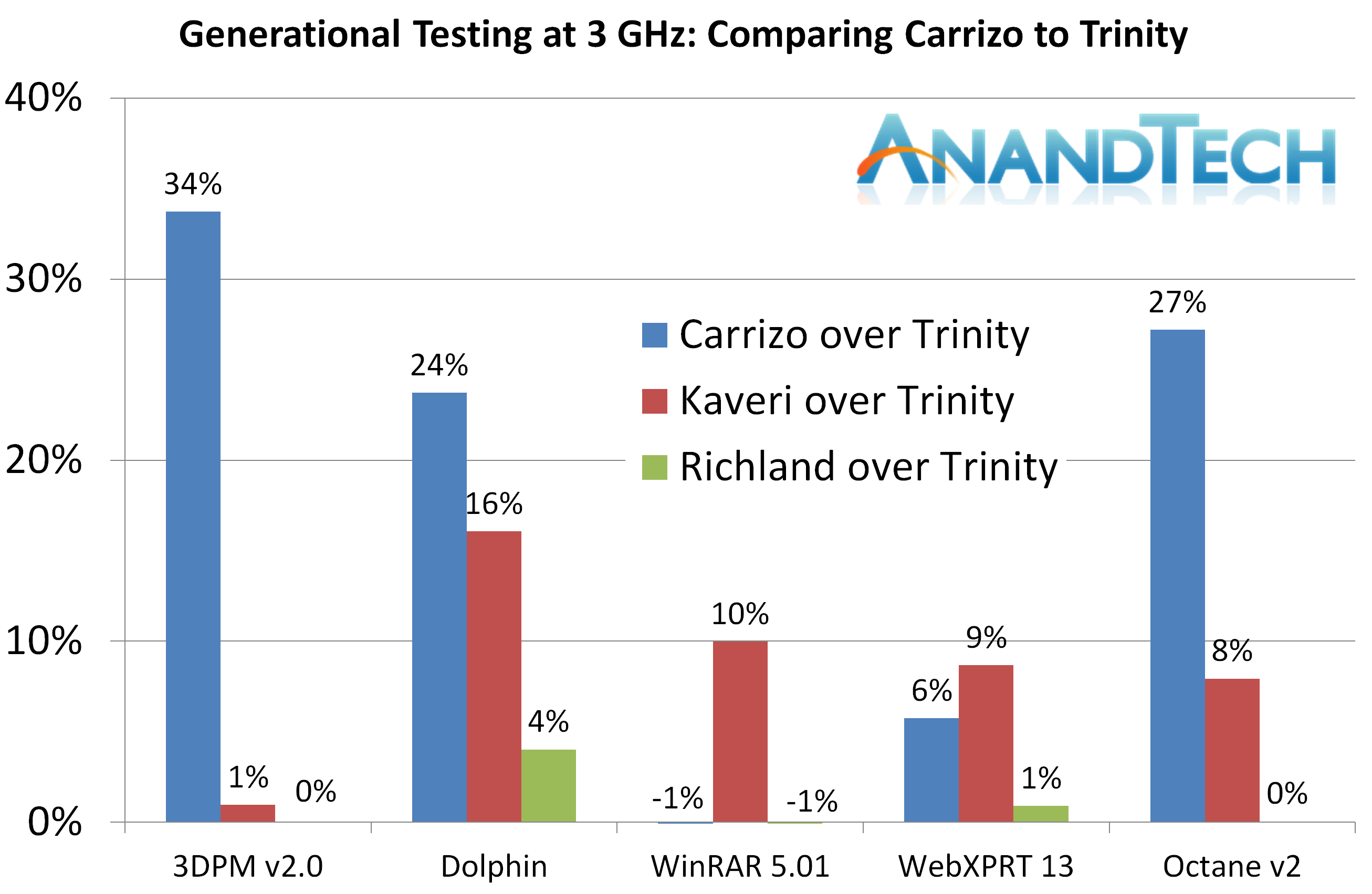
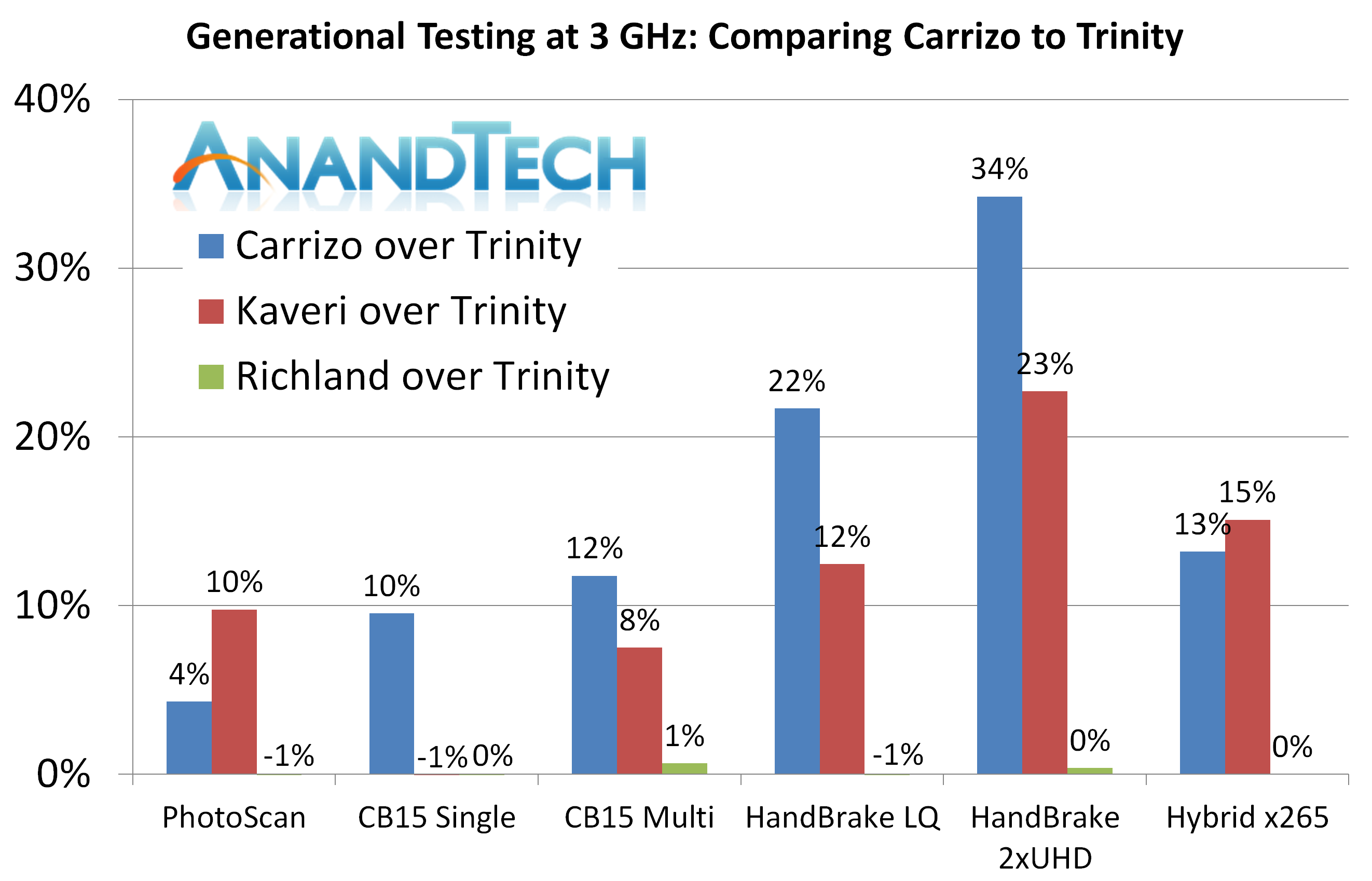
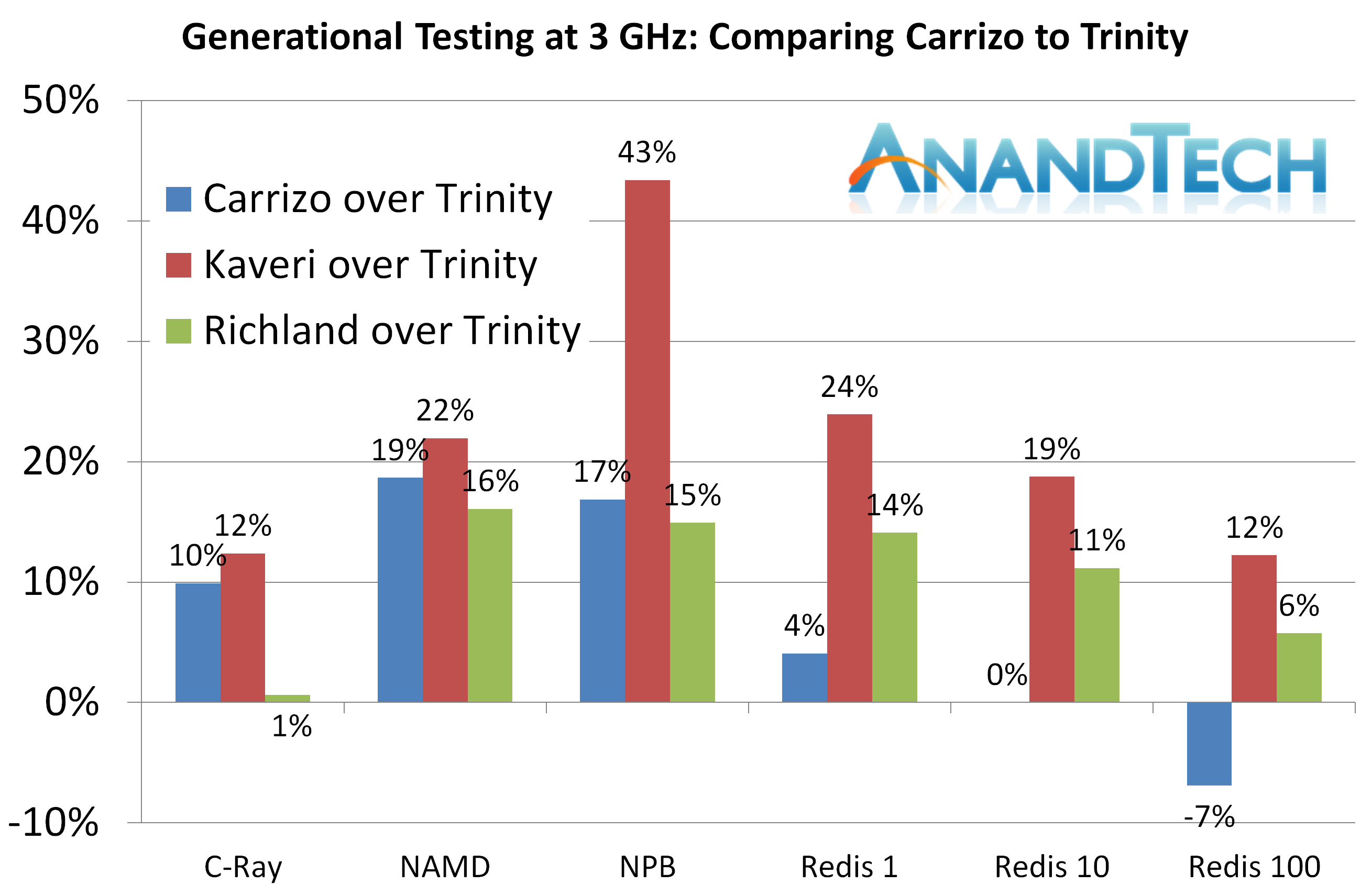
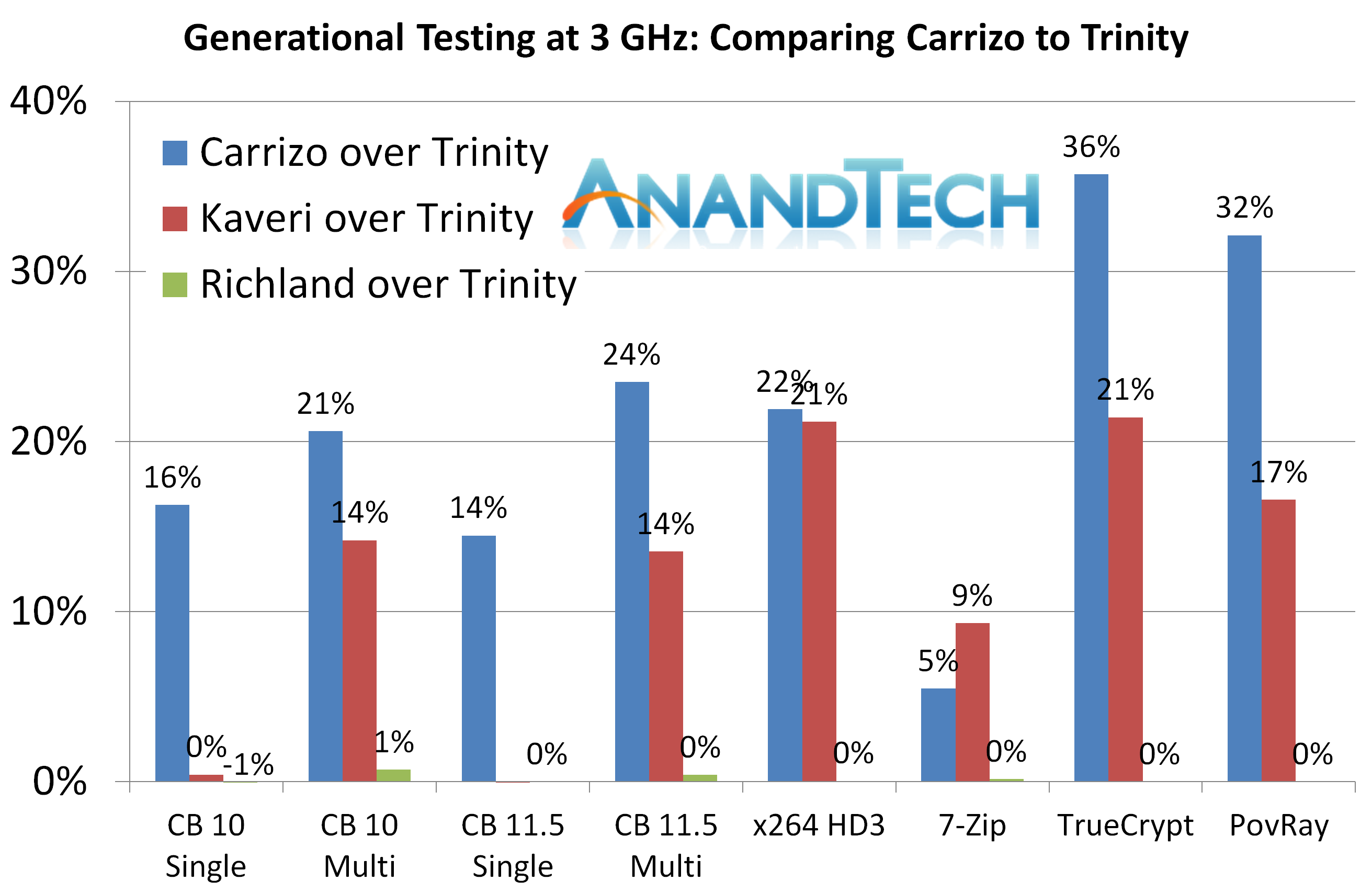

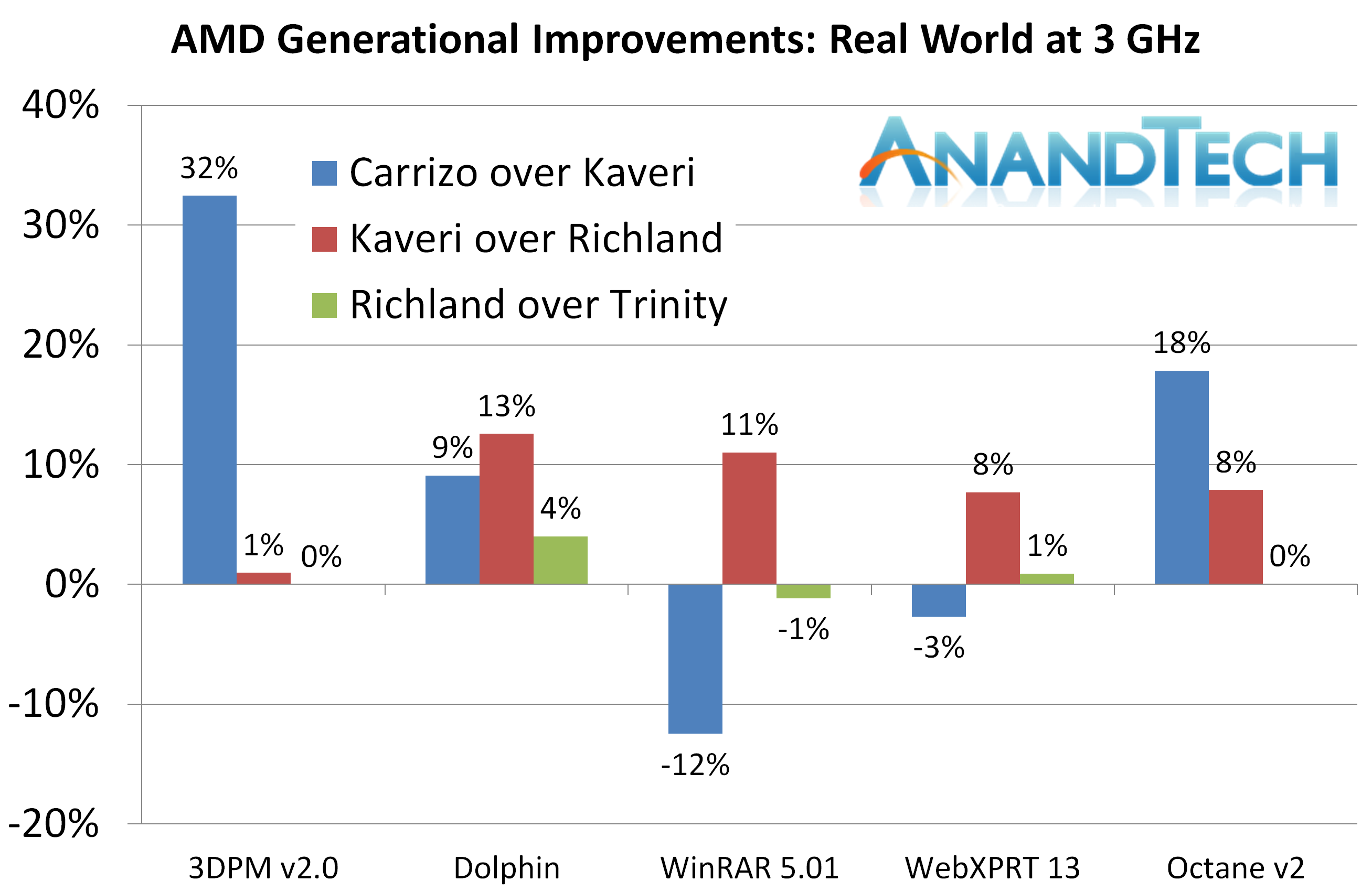


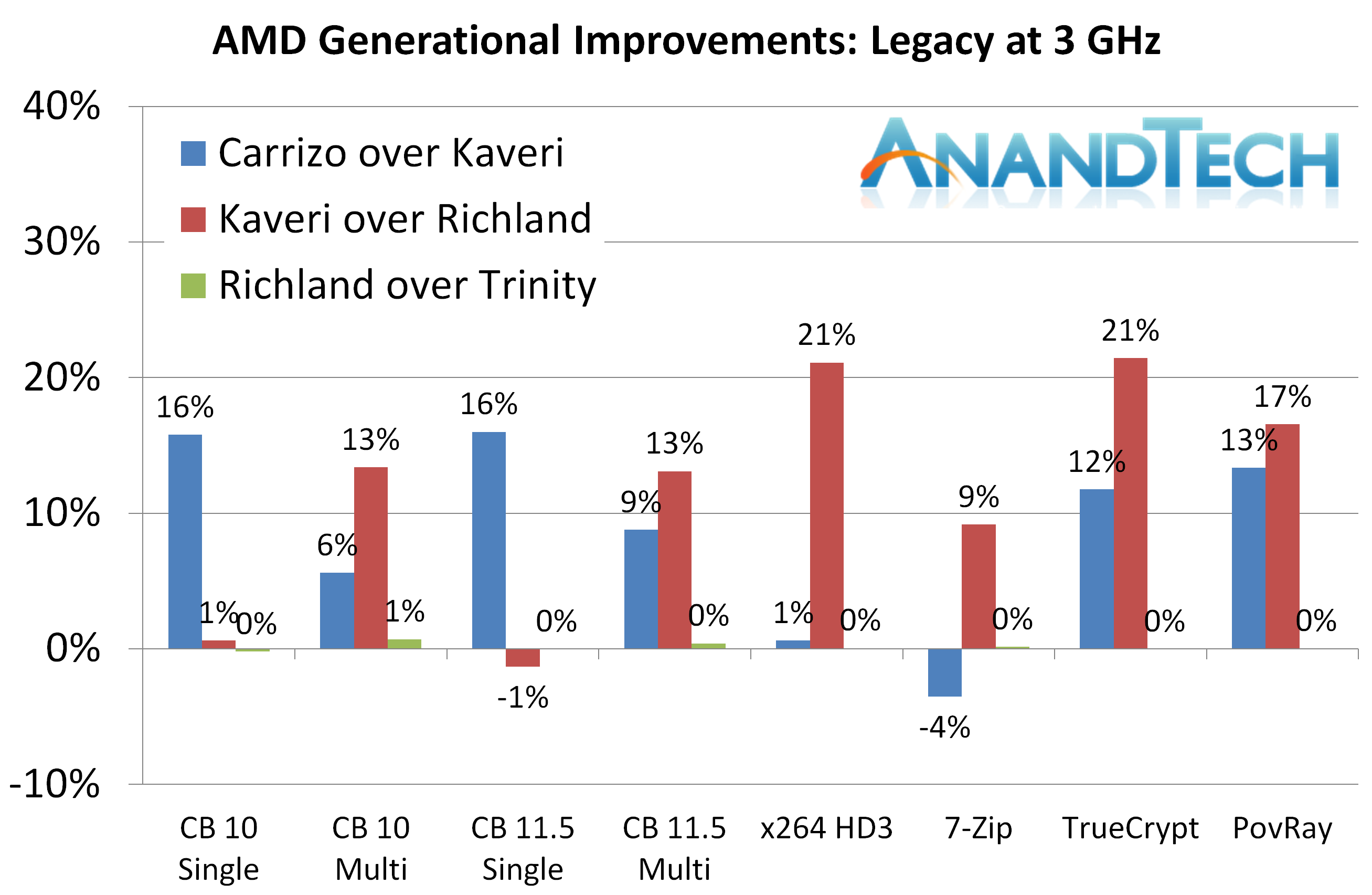
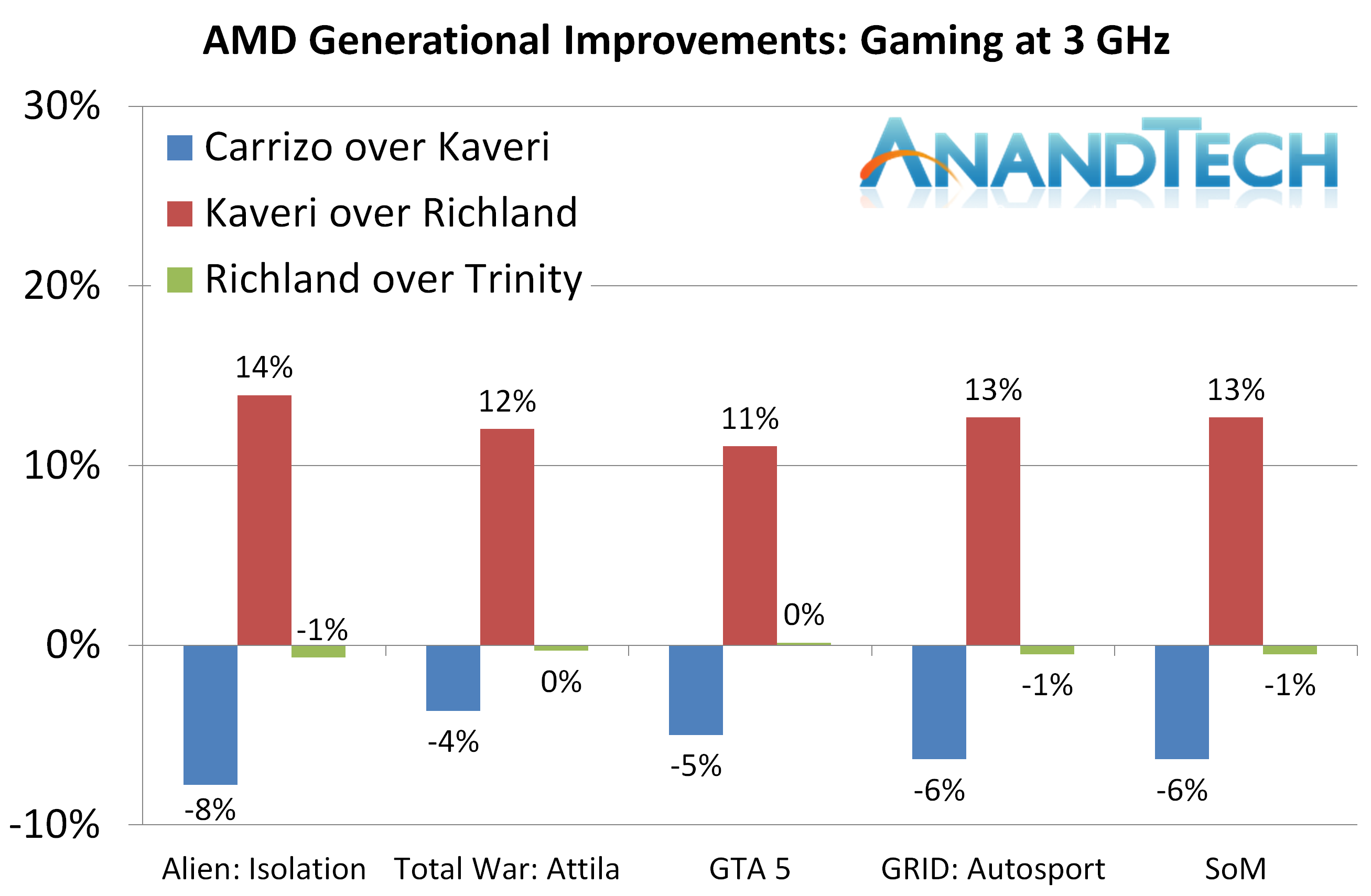








131 Comments
View All Comments
Peichen - Thursday, July 14, 2016 - link
I stopped reading at the messy chart where Athlon X4 750 is available from 2 µArch and there is no science to naming. AMD's CPU division was a bigger failure than its GPU division and it still it. I used to have 3 AMD systems at the same time back in 2005 but have steadily moved away and was considering replacing the last AMD system (Phenom II 840) using Prime Day sales.Ian Cutress - Thursday, July 14, 2016 - link
The 750 and 750K are two different SKUs. As mentioned, trying to find the 750 at retail (and in stock) is *really difficult*, and I'd probably point to it being an OEM-only SKU for a certain design. If anyone has a 750/can find one, let me know.artk2219 - Wednesday, July 20, 2016 - link
I found a link for one, but I think its just an OEM one, and it's from Aliexpress, so it may take a while to get to you. I hope I could help!http://www.aliexpress.com/item/AMD-Athlon-X4-750-A...
http://www.cpu-world.com/CPUs/Bulldozer/AMD-Athlon...
jefeweiss - Thursday, July 14, 2016 - link
I don't think poignant is the word you are looking for here. That would be something that makes you very sad, or emotionally touches you deeply.wallysb01 - Thursday, July 14, 2016 - link
I guess I don't totally understand the comparison to the G3258. I know its a fairly popular processor (I have its non-overclockable little brother, the G3250, and love it in a simple home office set up that I use occasionally for light gaming too). However, its 2 years old. Where is the G4500 or G4520? Supposedly the skylake Pentium would be about 10% faster than haswell, no? And with some perf/W gains too?Speaking of which, where's the comparison to Intel in the power consumption? Do I just not want to see that? If in these multithreaded tasks the 845 is chugging along using 80-85 W, while the Intel parts are still near their stated TDP, it more or less invalidates the small performance gain of the AMD chip in those tasks. Looking back at the skylake review, it seems at load the Intel chips might be using anything from 0-20% more than their TDP, this AMD chip is going 30% above.
I'd love it if AMD could push intel into offering more cores at lower price points, but this doesn't seem good enough to do that....
stardude82 - Thursday, July 14, 2016 - link
Tacking on a G4500 is not terribly pertinent to the task at hand and they are just using archived results here. The comparison from the 2 i3 parts should give you an idea of relative performance. Otherwise, I'm surprised we get such an in depth review from an hollowed out Anandtech.You are confusing TDP with total system draw.
You have a "four core" CPU here for $70, what more do you want? They soundly thrash the dual-core Pentiums and i3s in some well parallelized applications. The problem is the world isn't well parallelized and the CPUs don't have 4 real cores which is why you have i3s still competitive 8 core FX chips.
yannigr2 - Thursday, July 14, 2016 - link
WOW. This is an amazing work. It does explain too much about AMD's Bulldozer versions. It does explain why AMD doesn't bother to bring the full Carrizo line in desktop. It does show, at least from my perspective, that Bulldozer architecture was not a bad architecture to begin with, but a dead end from the beginning.artk2219 - Thursday, July 14, 2016 - link
Sigh, poor Llano and your FM1 package, always forgotten. Granted it was the last of the stars cores, and not a bulldozer derivative, but it would still be nice to see it included with its brethren.TheinsanegamerN - Thursday, July 14, 2016 - link
The last of AMD's good cores. Mobile Llano was fantastic for OCing and undervolting.artk2219 - Thursday, July 14, 2016 - link
Indeed it was/is, my fiance is still using my old Asus K53TA. I overclocked the A6 (back when A6's came with 4 cores) in that laptop to run at 2.4 instead of 1.4 for the base, and the turbo to 3Ghz. while overclocking i was able to undervolt at base clocks, and slightly overvolt the turbo clocks. In effect I got better battery life and waaayyyy better performance by just spending a little time playing with the P-States. I still think thats one of the best laptops I've ever owned in terms of reliability and capability, if only it weren't so clunky. Sigh, well you cant have it all.http://www.newegg.com/Product/Product.aspx?Item=N8...